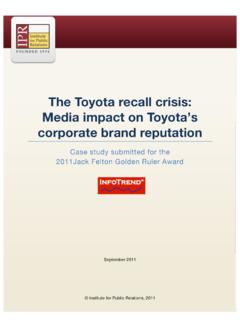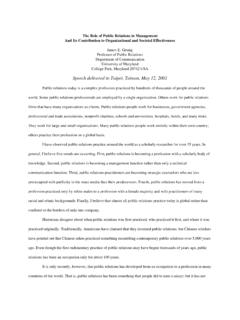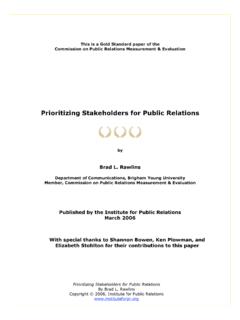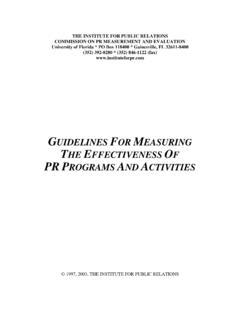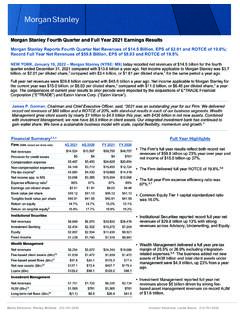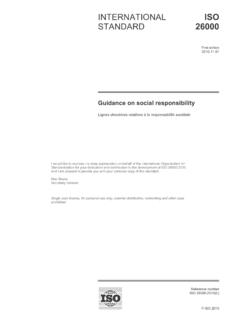Transcription of Prioritizing Stakeholders for Public Relations
1 Prioritizing Stakeholders for Public Relations By Brad L. Rawlins Copyright 2006, Institute for Public Relations This is a Gold Standard paper of the Commission on Public Relations Measurement & Evaluation Prioritizing Stakeholders for Public Relations by Brad L. Rawlins Department of Communications, Brigham Young University Member, Commission on Public Relations Measurement & Evaluation Published by the Institute for Public Relations March 2006 With special thanks to Shannon Bowen, Ken Plowman, and Elizabeth Stohlton for their contributions to this paper Prioritizing Stakeholders for Public Relations By Brad L.
2 Rawlins Copyright 2006, Institute for Public Relations Prioritizing Stakeholders 1 Prioritizing Stakeholders for Public Relations Brad L. Rawlins Department of Communications Brigham Young University Purpose of the White Paper By reviewing the literature in stakeholder theory, stakeholder management, and Public Relations , this paper arrives at a model that prioritizes Stakeholders through a four-step process: 1. Identifying all potential Stakeholders according to their relationship to the organization; 2. Prioritizing Stakeholders by attributes; 3. Prioritizing Stakeholders by relationship to the situation; 4.
3 Prioritizing the publics according to the communication strategy. What readers will find in this report Studies in stakeholder theory, stakeholder management, and Public Relations provide many different ways of identifying key Stakeholders or publics. At the heart of these attempts is the question, How much attention does each stakeholder group deserve or require? Since it is impossible that all Stakeholders will have the same interests in and demands on the firm, one scholar specifies that stakeholder management be about managing potential conflict stemming from diverging interests. 1 Once organizations have identified their Stakeholders , there is a struggle for attention: who to give it to, who to give more to, and who to not give it to at all.
4 Sacrificing the needs of one stakeholder for the needs of the other is a dilemma with which many organizations struggle. When these conflicts arise it is important to the success of the organization that it has prioritized each stakeholder according to the situation. By synthesizing research in stakeholder management and Public Relations , this paper will clarify the difference between a stakeholder and a Public , then provide a model that moves from the broadest attempts at identifying all Stakeholders , to the more specific need of identifying key publics for communication strategies. The model is situational, and priority of Stakeholders and publics will change according to the situation.
5 Defining Stakeholders and Publics The terms stakeholder and Public are often used interchangeably, but they shouldn t be. Stakeholders have been identified in the business literature according to their relationships to organizations. Publics, in the Public Relations and other mass media literature, are often identified according to their relationship to messages. 1 1 Winn, 2001. Building stakeholder Theory with a Decision Modeling Methodology, Business & Society, 40: 133-166. Prioritizing Stakeholders for Public Relations By Brad L. Rawlins Copyright 2006, Institute for Public Relations Prioritizing Stakeholders 2 Stakeholders .
6 The most quoted definition of a stakeholder in business literature is that given by Freeman, who says a stakeholder is any group or individual who is affected by or can affect the achievement of an organization s objectives. 2 This is what Freeman refers to as the wide sense of a stakeholder ; however, he also spoke of the narrow sense of a stakeholder when he described it as, any identifiable group or individual on which the organization is dependent for its continued survival. 3 The definition has been expanded to include groups who have interests in the corporation, regardless of the corporation s interest in Others have narrowed the definition to those who contribute to the financial bottom line of the Several scholars have criticized that the theory does not make clear who is a stakeholder and who is These scholars claim that stakeholder theory focuses heavily on the importance of meeting the needs of all Stakeholders , but does not tell anyone who the Stakeholders actually are or how to identify them.
7 It is because of this uncertainty that so many different, yet similar, definitions of who and what a stakeholder is have arisen. stakeholder management must move toward a names and faces orientation, with specific identification of and communication with Stakeholders , to avoid the anxiety of facing an infinite number of persons who have interest in, or are affected by the Employees, customers, shareholders, communities and suppliers are those most commonly classified as Stakeholders within an organization Publics. Publics is the term used for Stakeholders in the Public Relations literature. Because the Public Relations profession evolved from journalism, the term has frequently been related to the recipients of messages from organizations.
8 These publics, or more accurately, audiences, become segmented into more homogenous subsets that help communicators choose appropriate channels for reaching them. For example, publics can be employees, shareholders, political leaders, consumers, etc. These publics are often segmented even further by demographics, geographics, or psychographics. However, research in Public Relations has recently turned to the value of the relationships these publics have with organizations. This emphasis has encouraged adaptation of the term stakeholder in both practice and scholarship. James Grunig has differentiated the terms stakeholder and Public in the following way: organizations choose Stakeholders by their marketing strategies, recruiting, and investment plans, but publics arise on their own and choose the organization for attention.
9 8 Grunig relied 2 2 Freeman, R. E. 1984. Strategic Management: A stakeholder Approach. Boston: Pitman Publishing. 3 Freeman, , & Reed, 1983. Stockholders and Stakeholders : A new perspective on corporate governance. California Management Review, 25(3): 88-106. 4 Preston, , & Sapienza, (1990). stakeholder management and corporate performance. The Journal of Behavioral Economics, 19(4), 361-375. 5 Post, , Preston, , & Sachs, S. (2002). Managing the extended enterprise: The new stakeholder view. California Management Review, 45(1), 6-28. 6 Dunham, L.
10 , Freeman, R. E., & Liedtka, J. (2001). The soft underbelly of stakeholder theory: The role of community. Darden School Working Paper No. 01-22; Preston, , & Sapienza, (1990). stakeholder management and corporate performance. The Journal of Behavioral Economics, 19(4), 361-375; Jennings, M. M. (1999). stakeholder theory: Letting anyone who s interested run the business no investment required. Conference paper presented at corporate Governance: Ethics Across the Board, Houston, TX, April 6. 7 Dunham et al. 2001; Sternberg, E. 2001. The stakeholder Concept: A Mistaken Doctrine. Foundation for Business Responsibilities.
